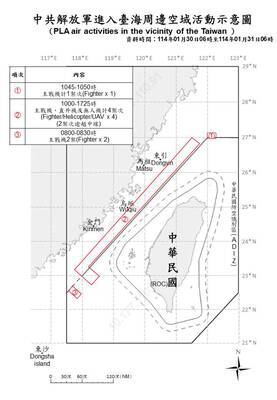More than 30 Chinese military aircraft were detected around Taiwan in a 24-hour window, the Ministry of National Defense said yesterday, marking the largest show of force around the nation since the Jan. 13 legislative and presidential elections.
In the 24 hours leading up to 6am yesterday, the ministry detected 33 Chinese military aircraft, including Su-30 fighters, and six naval ships operating around Taiwan, it said in a statement.
Thirteen of the aircraft “crossed the median line of the Taiwan Strait,” it said.

Photo courtesy of the Ministry of National Defense
The armed forces have “monitored the situation and employed [air patrol] aircraft, navy vessels and coastal missile systems in response to the detected activities,” it said.
Two Chinese balloons were also detected crossing the Taiwan Strait.
Days after Vice President William Lai (賴清德) — who has called himself a “pragmatic worker of Taiwanese independence,” although he has moderated his stance and vowed to follow President Tsai Ing-wen’s (蔡英文) path of maintaining the “status quo” — was elected president six Chinese balloons either flew over the nation or through airspace just north of it, the defense ministry has said.
The dispatch of such balloons, which generally disappear into the Pacific to the east, appears to be on the rise, although their purpose has not been publicly announced.
US National Security Council Coordinator for Strategic Communications John Kirby on Friday said that China should explain the reason for the balloons.
“We’re aware that there were some of these surveillance balloons that were flown, particularly in — before and around the time of the election,” Kirby told a White House news briefing when asked whether he was aware of these incursions and what he thinks is the purpose. “As I said at the time, these are questions that the Chinese government need to answer — what was the purpose and — and what they were doing.”
“I don’t — we — it wouldn’t be appropriate for us to answer that question. Clearly, we made — at the time, asserted that there should be no interference in the people of Taiwan’s ability to conduct free and fair elections,” he said.

UNITED: The premier said Trump’s tariff comments provided a great opportunity for the private and public sectors to come together to maintain the nation’s chip advantage The government is considering ways to assist the nation’s semiconductor industry or hosting collaborative projects with the private sector after US President Donald Trump threatened to impose a 100 percent tariff on chips exported to the US, Premier Cho Jung-tai (卓榮泰) said yesterday. Trump on Monday told Republican members of the US Congress about plans to impose sweeping tariffs on semiconductors, steel, aluminum, copper and pharmaceuticals “in the very near future.” “It’s time for the United States to return to the system that made us richer and more powerful than ever before,” Trump said at the Republican Issues Conference in Miami, Florida. “They

GOLDEN OPPORTUNITY: Taiwan must capitalize on the shock waves DeepSeek has sent through US markets to show it is a tech partner of Washington, a researcher said China’s reported breakthrough in artificial intelligence (AI) would prompt the US to seek a stronger alliance with Taiwan and Japan to secure its technological superiority, a Taiwanese researcher said yesterday. The launch of low-cost AI model DeepSeek (深度求索) on Monday sent US tech stocks tumbling, with chipmaker Nvidia Corp losing 16 percent of its value and the NASDAQ falling 612.46 points, or 3.07 percent, to close at 19,341.84 points. On the same day, the Philadelphia Stock Exchange Semiconductor Sector index dropped 488.7 points, or 9.15 percent, to close at 4,853.24 points. The launch of the Chinese chatbot proves that a competitor can

TAIWAN DEFENSE: The initiative would involve integrating various systems in a fast-paced manner through the use of common software to obstruct a Chinese invasion The first tranche of the US Navy’s “Replicator” initiative aimed at obstructing a Chinese invasion of Taiwan would be ready by August, a US Naval Institute (USNI) News report on Tuesday said. The initiative is part of a larger defense strategy for Taiwan, and would involve launching thousands of uncrewed submarines, surface vessels and aerial vehicles around Taiwan to buy the nation and its partners time to assemble a response. The plan was first made public by the Washington Post in June last year, when it cited comments by US Indo-Pacific Commander Admiral Samuel Paparo on the sidelines of the Shangri-La Dialogue

MARITIME SECURITY: Of the 52 vessels, 15 were rated a ‘threat’ for various reasons, including the amount of time they spent loitering near subsea cables, the CGA said Taiwan has identified 52 “suspicious” Chinese-owned ships flying flags of convenience that require close monitoring if detected near the nation, the Coast Guard Administration (CGA) said yesterday, as the nation seeks to protect its subsea telecoms cables. The stricter regime comes after a Cameroon-flagged vessel was briefly detained by the CGA earlier this month on suspicion of damaging an international cable northeast of Taiwan. The vessel is owned by a Hong Kong-registered company with a Chinese address given for its only listed director, the CGA said previously. Taiwan fears China could sever its communication links as part of an attempt